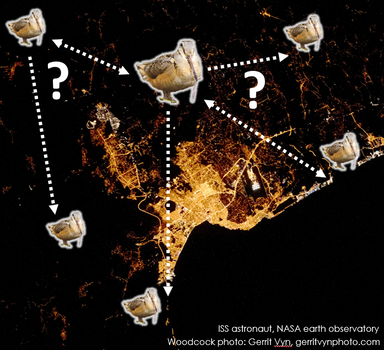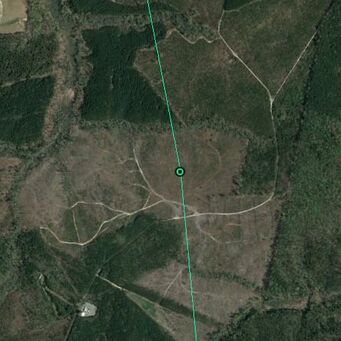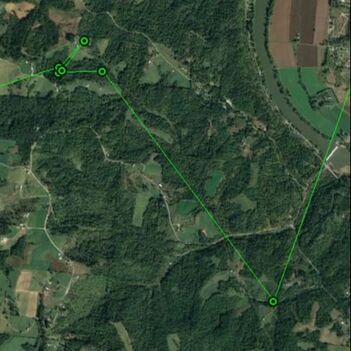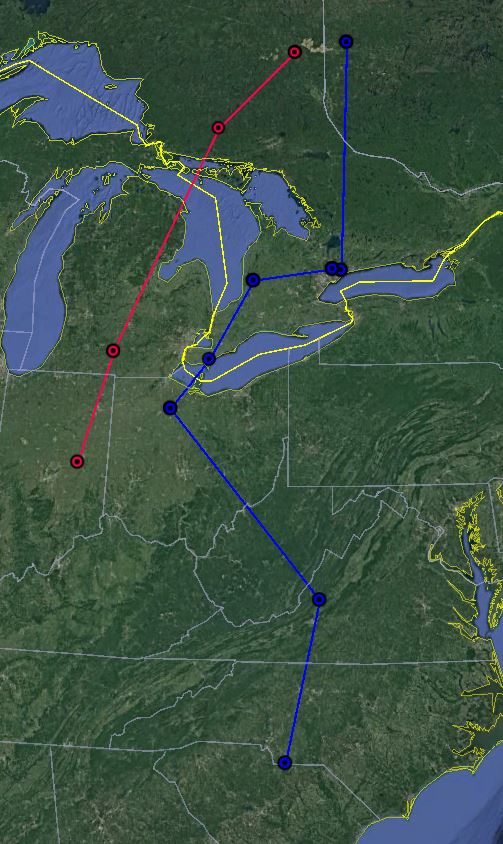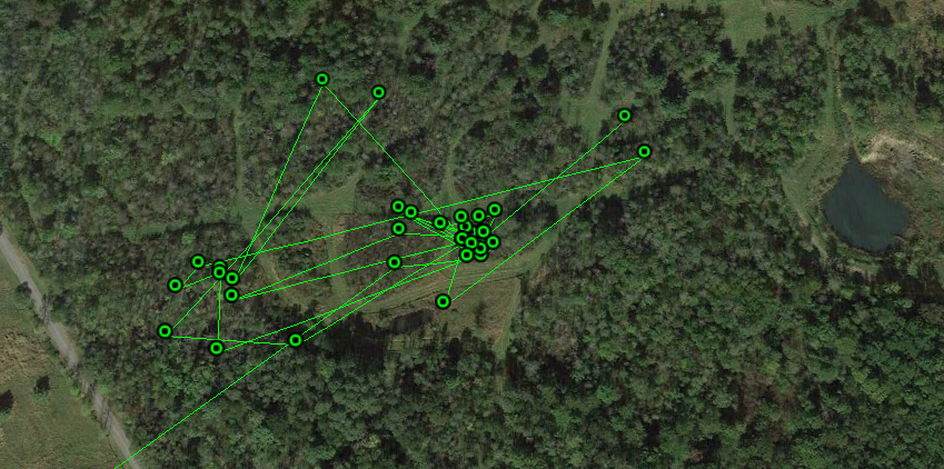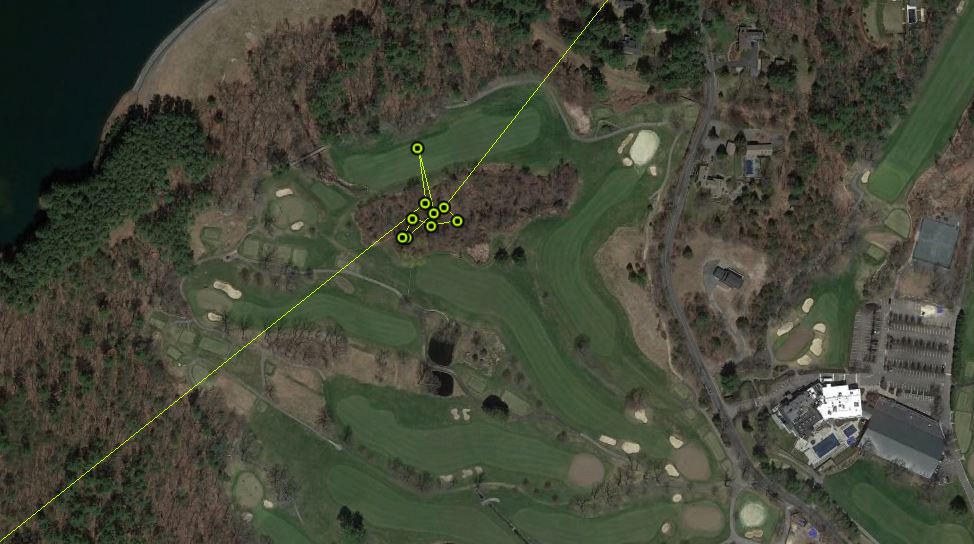migration
24 July 2024.
Over the past 1.5 months, birds from West Virginia and our single 2024 Wisconsin bird have regularly checked in. Most birds have remained stationary, with the following exceptions:
- WV-2024-41 left its tagging location and moved south to Virginia.
- WV-2024-55 moved about 55km southwest from his tagging site to an area near Two Lick Creek, still in the north-central area of the state.
All West Virginia tags will enter their dormant period as of August 6. The next burst of activity here will be during October/November, with birds being tagged in Nova Scotia prior to fall migration.
Check out our interactive map below to trace the journey of the birds tagged this winter and spring!
Over the past 1.5 months, birds from West Virginia and our single 2024 Wisconsin bird have regularly checked in. Most birds have remained stationary, with the following exceptions:
- WV-2024-41 left its tagging location and moved south to Virginia.
- WV-2024-55 moved about 55km southwest from his tagging site to an area near Two Lick Creek, still in the north-central area of the state.
All West Virginia tags will enter their dormant period as of August 6. The next burst of activity here will be during October/November, with birds being tagged in Nova Scotia prior to fall migration.
Check out our interactive map below to trace the journey of the birds tagged this winter and spring!
In our interactive mapping tool below, you can view woodcock locations for a specific range of dates (up to a year prior) by toggling the slider. During periods of major migration in the Fall (Oct 15-Dec 15) and Spring (Mar 1 through mid-May) we update the database regularly, but given transmitter upload frequencies and current transmitter schedules, we expect about a one week delay in our location data. Learn more about how our transmitter technology functions on our research page.
Spring & Summer 2024 Archive
Previous weeks' updates for 2024 Spring migration are below. For updates prior to Dec. 15 2023, see our Recent Migration and Migration Archives dropdown menus (under the Migration tab above), or visit our data exploration page to visualize previous years' migration data yourself.
10 June 2024.
All but one of our birds are stationary, spread across the species' breeding range. Expect updates to be posted less frequently over the summer, as most birds' GPS units will enter a dormant period. A couple notes:
- An adult male bird (WI-2024-03) was tagged by cooperators in central Wisconsin, and has remained stationary since.
- One bird tagged in West Virginia this spring, WV-2024-50, apparently unsatisfied with West Virginia, moved to Pennsylvania by June 3 and then Ontario by June 5.
13 May 2024.
Things are quieting down, with almost all birds remaining stationary on what we assume are their breeding grounds. A couple birds made relatively small movements in the last week:
- LA-2024-53 moving north of Québec City, then apparently deciding that was TOO far north, as this young male then moved back south of the St. Lawrence River.
- The one 2024 West Virginia bird (yet to be assigned a number) that moved into eastern Ohio has since returned to West Virginia.
6 May 2024.
All but two of our new 2024 deployments in West Virginia have checked in, with all but one bird remaining stationary at their tagging sites (Canaan Valley NWR, Little Indian WMA, Grant county, and Summersville Lake WMA).
LA-2024-34 moved 300km north from central Minnesota to western Ontario. All other Louisiana birds are stationary.
3 May 2024.
All of our Louisiana tagged birds are stationary, BUT...
We've received check-ins from two of our spring 2023 New York birds, NY-2023-53 and NY-2023-57, both adult males. 53 and 57 spent part their winters in western Mississippi and east of Atlanta, Georgia, respectively. Both were within 5km of their New York summering areas as of May 1, demonstrating high breeding site fidelity. We look forward to more of these birds checking in soon!
29 April 2024.
No additional movements since the 26th. At present, birds we tagged this winter in Louisiana are currently spread across the woodcock breeding range, from Manitoba to the St. Lawrence estuary in Québec, southwest Minnesota to the western lower peninsula of Michigan to eastern Maine.
Last week, our team assisted WVDNR starting their second year of GPS unit deployments - keep your eyes peeled for new birds popping up in these updates and on the map below!
26 April 2024.
Most of our birds have been stationary the last few days, with the following exceptions:
- LA-2024-38, a young female, moved northeast from near Montréal to the north coast of the St. Lawrence River, near where it widens into the Gulf.
- LA-2024-45, our young male that recently crossed Lake Huron into eastern Ontario, has changed direction and moved 300km west into central Ontario, north of Lake Superior.
- LA-2024-61, a young male in central Québec, recently moved 100km further north in the province.
- LA-2024-66, a young female, doesn't feel like settling down, and has been bouncing around western Québec for the last two weeks, cumulatively moving about 400km.
22 April 2024.
TL;DR: young birds tagged in Louisiana this winter keep moving north, adults are stationary; 3 birds tagged in West Virginia in spring 2023 checked in, two are demonstrating high breeding site fidelity.
A lot of check-ins and movements to report this week, including 3 birds from our 2023 captures in West Virginia! This update is a doozy:
- WV-2023-06, an adult male that summered in West Virginia, checked in from southeast Virginia in February. We expect to receive further data from him soon!
- WV-2023-20, an adult female that summered in Petroglyphs Provincial Park in Ontario spent her winter in Florida (what a smart bird!), and has returned to exactly the same site in Ontario as of April 15! That's some strong breeding site fidelity!
- WV-2023-23, an adult female who spent summer 2023 in Pennsylvania, wintered in northeast North Carolina, and by April 15 had returned to within 50km of her West Virginia capture site.
Our young Louisiana birds made further moves north last week:
- LA-2024-34 kept up her northward movements from last week, making it almost to Duluth, Minnesota by 4/21.
- In contrast, young male LA-2024-49 left Minnesota for the land of even MORE lakes, ending up in Manitoba, in between Lake Manitoba, Lake Winnipeg, and Lake Winnipegosis.
- LA-2024-43, a young male who spent 5+ weeks in southern Ohio, made a move northWEST, to the western lower peninsula of Michigan.
- In contrast, young male LA-2024-39 left the northeast corner of the lower peninsula of Michigan, presumably flying across Lake Huron to arrive in central Ontario.
- LA-2024-66, a young female, moved north from her 2 week stay in Pennsylvania to southern Quebec.
Other Louisiana birds are currently stationary in West Virginia, Ohio, Manitoba, Michigan, Ontario, and Maine.
We hope to hear from additional 2023-tagged birds in the next few weeks, stay tuned!
15 April 2024.
Five of our young birds (three females and two males) made north-ish moves in the last week or so, with most movement occurring within or to Michigan. Birds moved into the 'thumb', to the northeast coast of the lower peninsula, and into the central upper peninsula. One bird moved from Michigan's thumb into southern Quebec.
Of note, LA-2024-34, a young female, moved on from her month-long stay in western Kentucky (2/27 - 4/3) to central Indiana by 4/9.
08 April 2024.
Birds continue to move north and northeast! LA-2024-44, 45, 49 and 54 recently made movements directly north, ending in Manitoba, the Upper Peninsula of Michigan, Minnesota, and the Lower Peninsula of Michigan, respectively. LA-2024-65 and 66, both females, moved more eastward, from Kentucky to Toronto, Ontario, and Illinois to Pennsylvania, respectively.
Also, LA-2024-58, a young male that moved to the Maine coast during the recent snowstorm we received (and that we were concerned may have succumbed to it) has since checked back in, and is back inland near the Canadian border.
Our other birds have remained stationary, and likely are in the midst of breeding attempts.
01 April 2024.
One of our birds that last checked in from Louisiana on February 19, adult female LA-2024-37, has miraculously reappeared in southeast Minnesota! She's been there since March 11. LA-2024-51 moved more than 500km from Illinois/Indiana to central Iowa, and LA-2024-45 moved more than 400km from central Illinois to central Wisconsin.
29 March 2024.
A couple of our birds recently exhibited 'reverse migration', moving south instead of north, no doubt due to scarcity of food after last week's storms. See LA-2024-58 in Maine and LA-2024-44 in Iowa. Other birds have stayed put.
25 March 2024.
Most of our birds have stayed hunkered down in their same locations since last week, no doubt in part due to the recent large weather systems moving through the Midwest and Northeast. Let's hope our birds in the northeast have enough fat reserves to last until the snow melts, or can find accessible moving water nearby!
The only additional movement we saw was from LA-2024-60, who moved moving east-northeast along the St. Lawrence River from Montreal towards Quebec City by March 14, and has remained there since.
21 March 2024.
A couple notable northward movements to report from our young Louisiana males:
- LA-2024-58 moved approximately 1,200 kilometers in the last week, from NE Ohio all the way to the Maine-New Brunswick border!
- LA-2024-50 moved about 700 kilometers between March 14 and 17, from Harrisburg Pennsylvania to southern Quebec.
18 March 2024.
Our birds are on the move again! A second bird, coincidentally LA-2024-61, a young male, has joined LA-2024-60 in eastern Ontario. By March 14th, adult male LA-2024-46 was in central Wisconsin, and young female LA-2024-39 and young male LA-2024-55 both moved into the lower peninsula of Michigan, with 55 looking poised to fly across Lake Huron into Ontario. One of the last few birds in Louisiana, young female LA-2024-66, jumped over Arkansas and into southern Illinois by March 14th.
14 March 2024.
One big movement to report from our birds over the last few days: LA-2024-52, an adult male stopping over in Iowa for at least 13 days, made a jump up to northern Minnesota, near Duluth, by March 11! This means he overtakes LA-2024-60 (in eastern Ontario also as of March 11) as our current northernmost bird during spring migration!
11 March 2024.
We have not received any additional check-ins from our tagged birds over the last few days. This is expected, however, as these GPS tags are programmed to collect data at a less frequent rate than in previous seasons. We expect to see more data coming in later this week, stay tuned!
In other news, last night one of our colleagues heard a woodcock displaying near Orono, Maine - keep your eyes and ears open around dusk and dawn, they may be arriving near you soon!
08 March 2024.
Most of our birds remained stationary since March 6th. Our young males have been busy moving north, perhaps trying to catch ambitious females like LA-2024-60, or young female LA-2024-39, who recently moved north into central Illinois! Young males with recent movements include LA-2024-50 moving near Harrisburg Pennsylvania, and both LA-2024-55 and 61 moving into central Indiana.
06 March 2024.
A few more moves from our birds, with adult female LA-2024-60 pushing all the way to eastern Ontario, almost into Quebec! In contrast to this, LA-2024-35 has moved a little further south, back into Oklahoma. Most other birds that checked in since March 4th have remained stationary.
04 March 2024.
Our birds are continuing to push north, with several more moving into the Midwest (Iowa, Illinois, Indiana and Ohio), and an additional bird moving into both West Virginia and Pennsylvania. Males, females, young and adult birds are all on their way to their breeding grounds, making moves of hundreds of kilometers between stopover locations. We seem to have about equal numbers of birds moving towards Central and Eastern Management Regions, though some are making movements directly east rather than north/northeast (e.g. LA-2024-58's recent movement, the start of LA-2024-53's migration).
26 February 2024.
Most birds are now on the move, and moving north quickly! At least half a dozen are in Kentucky & Tennessee, two in Missouri, and one each in West Virginia, Indiana, and Illinois. Most of these are males, but a few our recently tagged females are also making moves north, with a couple in Kentucky and Arkansas, and one each in Mississippi and Missouri. Of note, LA-2024-35, moved north before all the other females, within the first week of February, into Oklahoma, and only recently moved slightly southward into Arkansas.
22 February 2024.
Our most recent data indicate a couple more woodcock have migrated! Both birds are young females (this is their first breeding season); one moved about 300km into central Mississippi, and the other about 750km into southeast Missouri.
20 February 2024.
Our birds are on the move! Of the 37 birds we tagged, all but one have checked in, and 13 have moved >100km from their tagging sites! These birds are currently in Arkansas, Kentucky, Tennessee, Mississippi, Alabama, and northern Louisiana. Check out their movements below, and check back over the next few weeks for more frequent updates on these and the other birds' migratory progress!
All but one of our birds are stationary, spread across the species' breeding range. Expect updates to be posted less frequently over the summer, as most birds' GPS units will enter a dormant period. A couple notes:
- An adult male bird (WI-2024-03) was tagged by cooperators in central Wisconsin, and has remained stationary since.
- One bird tagged in West Virginia this spring, WV-2024-50, apparently unsatisfied with West Virginia, moved to Pennsylvania by June 3 and then Ontario by June 5.
13 May 2024.
Things are quieting down, with almost all birds remaining stationary on what we assume are their breeding grounds. A couple birds made relatively small movements in the last week:
- LA-2024-53 moving north of Québec City, then apparently deciding that was TOO far north, as this young male then moved back south of the St. Lawrence River.
- The one 2024 West Virginia bird (yet to be assigned a number) that moved into eastern Ohio has since returned to West Virginia.
6 May 2024.
All but two of our new 2024 deployments in West Virginia have checked in, with all but one bird remaining stationary at their tagging sites (Canaan Valley NWR, Little Indian WMA, Grant county, and Summersville Lake WMA).
LA-2024-34 moved 300km north from central Minnesota to western Ontario. All other Louisiana birds are stationary.
3 May 2024.
All of our Louisiana tagged birds are stationary, BUT...
We've received check-ins from two of our spring 2023 New York birds, NY-2023-53 and NY-2023-57, both adult males. 53 and 57 spent part their winters in western Mississippi and east of Atlanta, Georgia, respectively. Both were within 5km of their New York summering areas as of May 1, demonstrating high breeding site fidelity. We look forward to more of these birds checking in soon!
29 April 2024.
No additional movements since the 26th. At present, birds we tagged this winter in Louisiana are currently spread across the woodcock breeding range, from Manitoba to the St. Lawrence estuary in Québec, southwest Minnesota to the western lower peninsula of Michigan to eastern Maine.
Last week, our team assisted WVDNR starting their second year of GPS unit deployments - keep your eyes peeled for new birds popping up in these updates and on the map below!
26 April 2024.
Most of our birds have been stationary the last few days, with the following exceptions:
- LA-2024-38, a young female, moved northeast from near Montréal to the north coast of the St. Lawrence River, near where it widens into the Gulf.
- LA-2024-45, our young male that recently crossed Lake Huron into eastern Ontario, has changed direction and moved 300km west into central Ontario, north of Lake Superior.
- LA-2024-61, a young male in central Québec, recently moved 100km further north in the province.
- LA-2024-66, a young female, doesn't feel like settling down, and has been bouncing around western Québec for the last two weeks, cumulatively moving about 400km.
22 April 2024.
TL;DR: young birds tagged in Louisiana this winter keep moving north, adults are stationary; 3 birds tagged in West Virginia in spring 2023 checked in, two are demonstrating high breeding site fidelity.
A lot of check-ins and movements to report this week, including 3 birds from our 2023 captures in West Virginia! This update is a doozy:
- WV-2023-06, an adult male that summered in West Virginia, checked in from southeast Virginia in February. We expect to receive further data from him soon!
- WV-2023-20, an adult female that summered in Petroglyphs Provincial Park in Ontario spent her winter in Florida (what a smart bird!), and has returned to exactly the same site in Ontario as of April 15! That's some strong breeding site fidelity!
- WV-2023-23, an adult female who spent summer 2023 in Pennsylvania, wintered in northeast North Carolina, and by April 15 had returned to within 50km of her West Virginia capture site.
Our young Louisiana birds made further moves north last week:
- LA-2024-34 kept up her northward movements from last week, making it almost to Duluth, Minnesota by 4/21.
- In contrast, young male LA-2024-49 left Minnesota for the land of even MORE lakes, ending up in Manitoba, in between Lake Manitoba, Lake Winnipeg, and Lake Winnipegosis.
- LA-2024-43, a young male who spent 5+ weeks in southern Ohio, made a move northWEST, to the western lower peninsula of Michigan.
- In contrast, young male LA-2024-39 left the northeast corner of the lower peninsula of Michigan, presumably flying across Lake Huron to arrive in central Ontario.
- LA-2024-66, a young female, moved north from her 2 week stay in Pennsylvania to southern Quebec.
Other Louisiana birds are currently stationary in West Virginia, Ohio, Manitoba, Michigan, Ontario, and Maine.
We hope to hear from additional 2023-tagged birds in the next few weeks, stay tuned!
15 April 2024.
Five of our young birds (three females and two males) made north-ish moves in the last week or so, with most movement occurring within or to Michigan. Birds moved into the 'thumb', to the northeast coast of the lower peninsula, and into the central upper peninsula. One bird moved from Michigan's thumb into southern Quebec.
Of note, LA-2024-34, a young female, moved on from her month-long stay in western Kentucky (2/27 - 4/3) to central Indiana by 4/9.
08 April 2024.
Birds continue to move north and northeast! LA-2024-44, 45, 49 and 54 recently made movements directly north, ending in Manitoba, the Upper Peninsula of Michigan, Minnesota, and the Lower Peninsula of Michigan, respectively. LA-2024-65 and 66, both females, moved more eastward, from Kentucky to Toronto, Ontario, and Illinois to Pennsylvania, respectively.
Also, LA-2024-58, a young male that moved to the Maine coast during the recent snowstorm we received (and that we were concerned may have succumbed to it) has since checked back in, and is back inland near the Canadian border.
Our other birds have remained stationary, and likely are in the midst of breeding attempts.
01 April 2024.
One of our birds that last checked in from Louisiana on February 19, adult female LA-2024-37, has miraculously reappeared in southeast Minnesota! She's been there since March 11. LA-2024-51 moved more than 500km from Illinois/Indiana to central Iowa, and LA-2024-45 moved more than 400km from central Illinois to central Wisconsin.
29 March 2024.
A couple of our birds recently exhibited 'reverse migration', moving south instead of north, no doubt due to scarcity of food after last week's storms. See LA-2024-58 in Maine and LA-2024-44 in Iowa. Other birds have stayed put.
25 March 2024.
Most of our birds have stayed hunkered down in their same locations since last week, no doubt in part due to the recent large weather systems moving through the Midwest and Northeast. Let's hope our birds in the northeast have enough fat reserves to last until the snow melts, or can find accessible moving water nearby!
The only additional movement we saw was from LA-2024-60, who moved moving east-northeast along the St. Lawrence River from Montreal towards Quebec City by March 14, and has remained there since.
21 March 2024.
A couple notable northward movements to report from our young Louisiana males:
- LA-2024-58 moved approximately 1,200 kilometers in the last week, from NE Ohio all the way to the Maine-New Brunswick border!
- LA-2024-50 moved about 700 kilometers between March 14 and 17, from Harrisburg Pennsylvania to southern Quebec.
18 March 2024.
Our birds are on the move again! A second bird, coincidentally LA-2024-61, a young male, has joined LA-2024-60 in eastern Ontario. By March 14th, adult male LA-2024-46 was in central Wisconsin, and young female LA-2024-39 and young male LA-2024-55 both moved into the lower peninsula of Michigan, with 55 looking poised to fly across Lake Huron into Ontario. One of the last few birds in Louisiana, young female LA-2024-66, jumped over Arkansas and into southern Illinois by March 14th.
14 March 2024.
One big movement to report from our birds over the last few days: LA-2024-52, an adult male stopping over in Iowa for at least 13 days, made a jump up to northern Minnesota, near Duluth, by March 11! This means he overtakes LA-2024-60 (in eastern Ontario also as of March 11) as our current northernmost bird during spring migration!
11 March 2024.
We have not received any additional check-ins from our tagged birds over the last few days. This is expected, however, as these GPS tags are programmed to collect data at a less frequent rate than in previous seasons. We expect to see more data coming in later this week, stay tuned!
In other news, last night one of our colleagues heard a woodcock displaying near Orono, Maine - keep your eyes and ears open around dusk and dawn, they may be arriving near you soon!
08 March 2024.
Most of our birds remained stationary since March 6th. Our young males have been busy moving north, perhaps trying to catch ambitious females like LA-2024-60, or young female LA-2024-39, who recently moved north into central Illinois! Young males with recent movements include LA-2024-50 moving near Harrisburg Pennsylvania, and both LA-2024-55 and 61 moving into central Indiana.
06 March 2024.
A few more moves from our birds, with adult female LA-2024-60 pushing all the way to eastern Ontario, almost into Quebec! In contrast to this, LA-2024-35 has moved a little further south, back into Oklahoma. Most other birds that checked in since March 4th have remained stationary.
04 March 2024.
Our birds are continuing to push north, with several more moving into the Midwest (Iowa, Illinois, Indiana and Ohio), and an additional bird moving into both West Virginia and Pennsylvania. Males, females, young and adult birds are all on their way to their breeding grounds, making moves of hundreds of kilometers between stopover locations. We seem to have about equal numbers of birds moving towards Central and Eastern Management Regions, though some are making movements directly east rather than north/northeast (e.g. LA-2024-58's recent movement, the start of LA-2024-53's migration).
26 February 2024.
Most birds are now on the move, and moving north quickly! At least half a dozen are in Kentucky & Tennessee, two in Missouri, and one each in West Virginia, Indiana, and Illinois. Most of these are males, but a few our recently tagged females are also making moves north, with a couple in Kentucky and Arkansas, and one each in Mississippi and Missouri. Of note, LA-2024-35, moved north before all the other females, within the first week of February, into Oklahoma, and only recently moved slightly southward into Arkansas.
22 February 2024.
Our most recent data indicate a couple more woodcock have migrated! Both birds are young females (this is their first breeding season); one moved about 300km into central Mississippi, and the other about 750km into southeast Missouri.
20 February 2024.
Our birds are on the move! Of the 37 birds we tagged, all but one have checked in, and 13 have moved >100km from their tagging sites! These birds are currently in Arkansas, Kentucky, Tennessee, Mississippi, Alabama, and northern Louisiana. Check out their movements below, and check back over the next few weeks for more frequent updates on these and the other birds' migratory progress!
